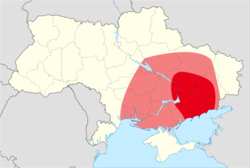Free Territory
| Free Territory | ||||||||||||
| Вільна територія | ||||||||||||
| Stateless territory | ||||||||||||
|
||||||||||||
|
Motto "Смерть всім, хто стоїть на перешкоді здобуття вільності трудовому люду!" (Ukrainian) "Death to all who stand in the way of obtaining the freedom of working people!" |
||||||||||||
|
Approximate location of the Free Territory in present-day Ukraine
|
||||||||||||
| Capital | Huliaipole | |||||||||||
| Languages |
Ukrainian Russian |
|||||||||||
| Government | Anarcho-communist quasi- | |||||||||||
| Military leader | ||||||||||||
| • | 1919–1921 | Nestor Makhno | ||||||||||
| Historical era | Russian Civil War | |||||||||||
| • | Established | 1918 | ||||||||||
| • | Disestablished | 1921 | ||||||||||
| Population | ||||||||||||
| • | est. | 7 million | ||||||||||
|
||||||||||||
| Today part of | ||||||||||||
The Free Territory (Ukrainian: Вільна територія vilna terytoriya; Russian: свободная территория svobodnaya territoriya) or Makhnovia (Махновщина Makhnovshchyna) resulted from an attempt to form a stateless anarchist society during the Ukrainian Revolution of 1917 to 1921. It existed from 1918 to 1921, during which time "free soviets" and libertarian communes operated under the protection of Nestor Makhno's Revolutionary Insurrectionary Army. The area had a population of around seven million.
Russian forces of the White movement under Anton Denikin occupied the territory and formed a temporary government of Southern Russia in March 1920, but in late March 1920 Denikin's forces retreated from the area, driven out by the Red Army in cooperation with Makhno's forces, whose units conducted guerrilla warfare behind Denikin's lines.
As the Free Territory self-organized along anarchist principles, references to "control" and "government" are highly contentious. For example, the Makhnovists, often cited as a form of government (with Nestor Makhno as their "leader"), played a purely military role, with Makhno himself functioning as little more than a military strategist and advisor.
...
Wikipedia


